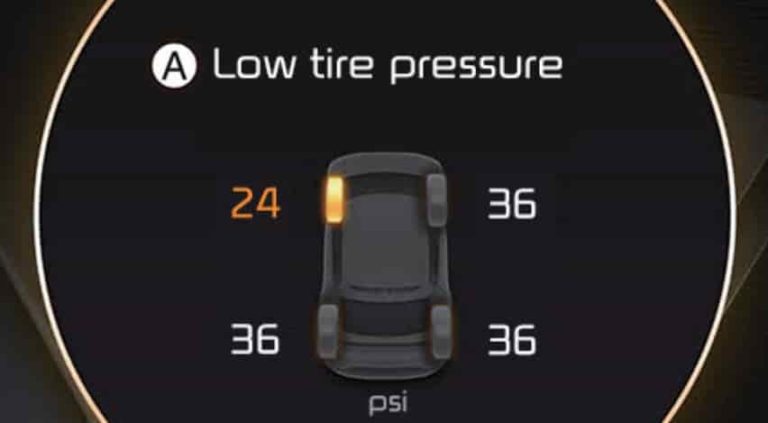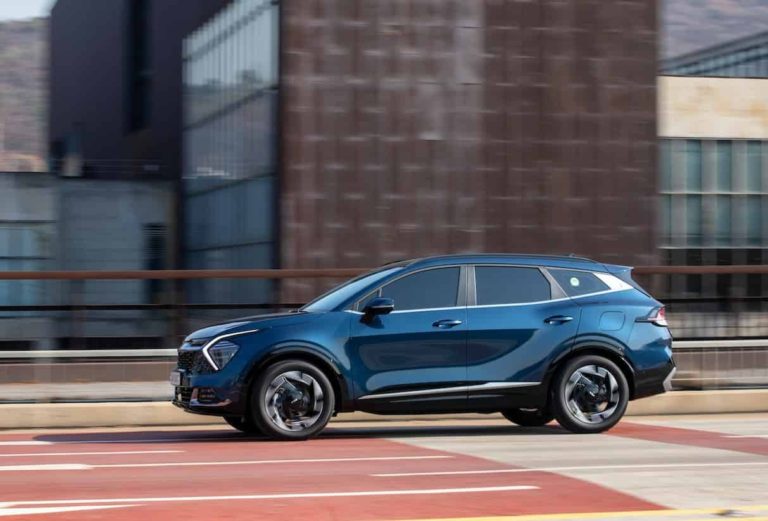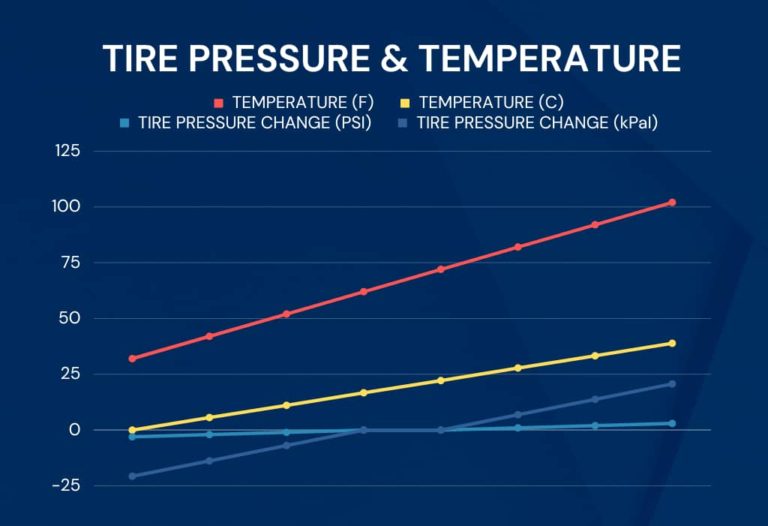Low Tire Pressure Light
Before delving into the specifics, it’s crucial to understand that the Kia Sportage does not have a tire pressure reset button. As a result, you can disregard any videos or websites suggesting its existence – it’s just not there. Fear not! By following the steps in this article, you’ll successfully turn off your tire pressure light with no problems at all.
What is the TPMS in the Kia Sportage?
It can be frustrating when that yellow exclamation mark appears on your dashboard, but it serves a crucial purpose! The tire pressure monitoring system (TPMS) in your Kia Sportage is an essential safety component that monitors your vehicle’s tire condition. Its main role is to ensure a smooth driving experience and safeguard passengers by notifying the driver of any variations in tire pressure from the predetermined levels. To check your tire pressure: scroll to the info page on your LCD screen by pressing the mode button on your steering wheel. Or, check the sticker on the driver side door panel. Pay attention to Front and Rear pressures as they may differ.
Steps to Reset the kia Sportage Low Tire Pressure Light
The Kia Sportage does not have a tire pressure reset button.
When the tire pressure light on the dashboard lights up, pull over and check your tire pressure right away.
Determine which tire is causing the tire pressure light to turn on and adjust the tire pressure accordingly.
Fill your tire to the exact recommended pressures. I cannot emphasize this enough, accuracy is key.
Drive your Kia Sportage. Drive for a few minutes at speeds over 20 Mph.
If the light doesn’t go off right away, re-check your tire pressure to make sure they are all at the exact pressure you set them to. If they are down in pressure, you probably have some sort of tire leak.
If the pressures are at the exact pressure you set them to and the tire light still won’t go off, over fill your tires.
We recommend filling your problem tire with 45 Psi or about 10 Psi over the recommended pressure. With the tire overfilled, drive the car again for 10 or 15 minutes. This will turn off the tire light.
Now that the tire light is off, readjust the pressure back to the recommended pressure.
How Does the Kia Sportage TPMS Work?
Sensors: The Kia Sportage’s tire pressure system has sensors mounted on the end of each valve stem to measure air pressure and temperature of each tire.
Wireless data transmission: The sensors wirelessly transmit the tire pressure data to the car’s TPMS control unit and ECU/ECM using radio frequencies.
Continuous monitoring: The TPMS control unit continually analyzes and measures the tire pressure data received from the sensors.
Pressure comparison: The system compares the measured tire pressure against the recommended levels set by Kia for the Sportage.
Warning activation: If the measured tire pressure is below the recommended levels, the TPMS triggers a warning.
Dashboard display: The TPMS warning light appears on the dashboard LCD with a yellow exclamation point.
Tire identification: The Kia Sportage’s tire pressure system indicates which specific tire is experiencing a pressure issue.
Regular monitoring: The TPMS continuously monitors and measures your tire pressure while driving.
Kia Sportage TPMS Malfunction Indicator
Your Kia Sportage also has a special warning light to alert you to potential issues with your tire pressure monitoring system (TPMS). This warning light displays a yellow exclamation point, identical to the tire warning light. If there is a problem with the TPMS, the light will flash for approximately one minute before staying on. This sequence will occur every time you start your car until the issue is resolved. So, when your tire light is flashing or blinking, the system may not be able to accurately detect low tire pressure. In conclusion, a blinking tire pressure light typically signals a malfunction within the TPMS itself, rather than an actual tire pressure concern. Often, this is due to a defective pressure sensor in one of your tires.
What are Common Causes for the Low Tire Pressure Light to Turn On?
Seasonal temperature changes: A drop in ambient temperature can cause tire pressure to decrease, triggering the warning light.
Tire puncture or leak: A sharp object or road debris like a nail or screw may puncture a tire, causing air loss which will of course activate the warning light.
Faulty tire pressure sensor: Damaged or malfunctioning sensors may provide inaccurate readings, resulting in a false alert. The only way to determine which sensor is faulty is to scan each sensor with a TPMS diagnostic tool.
Valve stem issues: A damaged or leaking valve stem can lead to gradual pressure loss and eventual activation of the tire pressure light. They make kits to replace the rubber gasket that usually goes bad.
Tire damage: Impact from potholes or hitting a curb can cause structural damage like tire bubbles, leading to pressure loss.
Sensor battery life: TPMS sensors are battery-powered, and over time, batteries die. (they usually last anywhere from 5-10 years) This will cause the tire pressure light to turn on. Again, you must use a diagnostic tool to determine which sensor is dead or dying.
Recent tire rotation or replacement: If the tires have been recently rotated or replaced, the TPMS may need recalibration to avoid false alerts. Sometimes the vehicle’s computer may think the front tires are in the rear and rear in the front after a rotation.
Wheel or rim issues: Damaged, corroded, or cracked wheels or rims can lead to air leaks and pressure loss. This is very common with low profile tires.
Altitude changes: Climbing or descending in elevation can affect tire pressure and trigger the TPMS warning.
Natural pressure loss: Tires lose air pressure over time due to temperature changes and permeation. Tire dry-rot will happen to tires that sit.
Electrical problems or software issues within the car’s TPMS system. Occasionally the system may have a software update.
What Happens When Tires are Underinflated?
When tires are underinflated, it leads to a series of issues that can impact your driving experience, safety, and even your wallet! First, underinflated tires have a larger contact patch with the road. This will cause increased friction and, consequently, more heat generation. This excessive heat can result in accelerated tire tread and sidewall wear, reducing their lifespan and forcing you to replace them sooner than expected.
Furthermore, underinflated tires negatively affect your vehicle’s handling and stability. The tires become less responsive, and cornering becomes less precise, putting you at a higher risk for accidents. Underinflated tires also compromise your vehicle’s fuel efficiency. The increased rolling resistance means your engine has to work harder to maintain speed, causing it to consume more fuel. Lastly, underinflated tires are more susceptible to punctures and blowouts. The added stress on the tire sidewalls and weakened structural integrity can lead to tire failure, which can be especially dangerous while driving at high speeds.
Does the Weather Affect Tire Pressure?
Weather affects the tire pressure in your Kia Sportage. When it’s cold outside, the tire pressure goes down, and when it’s warm, the tire pressure goes up. This happens because air inside the tires expands and shrinks with temperature changes. Keep an eye on your tire pressure when the weather changes. It’s very common during cold seasons that your tire pressure light will turn on. The rule is: for every 10 degrees of temperature change, your tire pressure changes by about 1 Psi.
What are the Benefits of the Kia Sportage TPMS?
The Kia Sportage’s tire pressure monitoring system (TPMS) is a very underrated safety feature that gives you peace of mind while driving. It offers numerous benefits that enhance your driving experience and safety. The tire pressure system not only improves your vehicle’s handling and stability but also contributes to a more comfortable and efficient ride. Additionally, well-maintained tire pressure helps reduce tire tread wear, leading to cost savings and a longer tire lifespan. The TPMS also plays a role in promoting eco-friendly driving by optimizing fuel consumption. In short, the Kia Sportage’s TPMS provides invaluable assistance, giving you confidence and peace of mind while you’re behind the wheel.
Conclusion
In conclusion, the tire pressure monitoring system (TPMS) in your Kia Sportage is an indispensable safety feature designed to optimize your driving experience, enhance fuel efficiency, and promote responsible tire maintenance. While the absence of a tire pressure reset button might seem perplexing, following the tips and procedures outlined in this article will help you address any tire pressure concerns with ease. So, stay proactive and give your tires the attention they deserve! Everything in this article is applicable to all Kia Sportage models and trims, including the Sportage Hybrid and Sportage Plug-in Hybrid.





